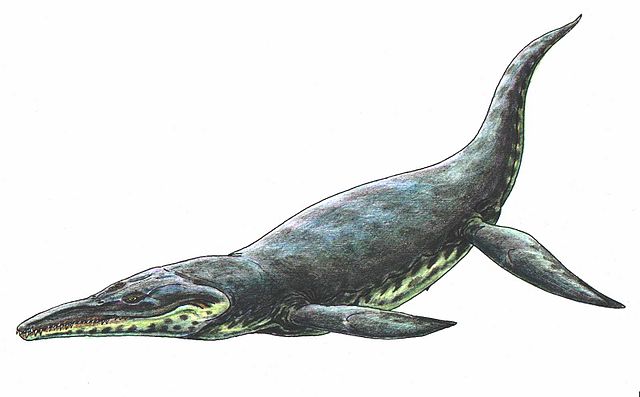
Life reconstruction of the giant (length to 10 meters) advanced pliosaurid Kronosaurus queenslandicus, from the Middle Cretaceous (Aptian-Albian) of Queensland (south-central Gondwana).
Artwork by Dmitry Bogdanov. Wikipedia, Public Domain
| Sauropterygia | ||
| The Vertebrates | Pliosauridae |
| Vertebrates Home | Vertebrate | Vertebrate |
|
Abbreviated Dendrogram
Diapsida
├─Archosauromorpha
│
└─Lepidosauromorpha
├─Sauropterygia
│ ├─Placodontia
│ ├─Pachypleurosauridae
│ └─┬─Nothosauridae
│ └─Plesiosauria
│ ├─Pliosauroidea
│ │ ├─Rhomaleosauridae
│ │ └─Pliosauridae
│ │ ├─Maresaurus
│ │ ├─Plesiopleurodon
│ │ ├─Macroplata
│ │ └─┬─Kronosaurus
│ │ └─┬─Peloneustes
│ │ └─┬─Liopleurodon
│ │ └─┬─Pliosaurus
│ │ └─Brachauchenius
│ └─Plesiosauroidea
│ ├─Elasmosauridae
│ └─Cryptocleidoidea
└─Lepidosauriformes
├─Sphenodontia
└─Squamata
|
Contents
Overview |
 Life reconstruction of the giant (length to 10 meters) advanced pliosaurid Kronosaurus queenslandicus, from the Middle Cretaceous (Aptian-Albian) of Queensland (south-central Gondwana). Artwork by Dmitry Bogdanov. Wikipedia, Public Domain |
 It is often said that the short-necked Pliosauridae were "the killer whales of the Mesozoic." In fact, the two groups have very little in common beyond a superficially similar body plan and -- perhaps -- a similar ecological niche. Like the killer whales, the pliosaurids were large marine tetrapods with huge skulls and relatively short necks (about 13 cervical vertebrae). It seems they also had a small vertical tail fin. Their sizes ranged from 3 to 12 or possibly even more in length. The head alone was 3 meters or more in length in the larger forms. Examples of pliosaurids are Pliosaurus, Peloneustes, and Liopleurodon. The relationship of the pliosauroid Kronosaurus is uncertain, although it is treated here as a pliosaurid.
It is often said that the short-necked Pliosauridae were "the killer whales of the Mesozoic." In fact, the two groups have very little in common beyond a superficially similar body plan and -- perhaps -- a similar ecological niche. Like the killer whales, the pliosaurids were large marine tetrapods with huge skulls and relatively short necks (about 13 cervical vertebrae). It seems they also had a small vertical tail fin. Their sizes ranged from 3 to 12 or possibly even more in length. The head alone was 3 meters or more in length in the larger forms. Examples of pliosaurids are Pliosaurus, Peloneustes, and Liopleurodon. The relationship of the pliosauroid Kronosaurus is uncertain, although it is treated here as a pliosaurid.
Among Jurassic forms, Pliosaurus and Liopleurodon were were the giants of the oceans, around 7 to 12 metres in length; although large forms may have been even bigger. The skull and snout were heavy and elongated. The conical teeth bore numerous vertical ridges. The neck short and thick, and the body streamlined. There were about 23 cervical and 24 dorsal vertebrae. MAK990814, ATW020704.
 Pliosauridae: Pliosaurus > Rhomaleosaurus. Plesiosauria Translation and Pronunciation Guide
Pliosauridae: Pliosaurus > Rhomaleosaurus. Plesiosauria Translation and Pronunciation Guide
Range: Middle Jurassic to Late Cretaceous
Phylogeny: Pliosauroidea::: Rhomaleosauridae + *: Maresaurus + Plesiopleurodon + Macroplata + (Kronosaurus + (Peloneustes + (Liopleurodon + (Pliosaurus + Brachauchenius)))).
Characters: very large skulls (on the order of 25-30% total length); 13 cervical vertebrae in derived forms.
Image: Macroplata. Image by Steve Kirk, from Cox et al. (1988)
Links: Pliosauridae after O'Keefe, 2001; IL Geo Survey Past Dinosaur Questions; p3 - pliosaur2.jpg (teeth); Plesiosauria Translation and Pronunciation Guide; Re: Megalneusaurus rex (fwd). ATW020704.
Maresaurus: M. coccai Gasparini 1997.
Range: Middle Jurassic (Bajocian) of South America
Phylogeny: Pliosauridae: Plesiopleurodon + Macroplata + (Kronosaurus + (Peloneustes + (Liopleurodon + (Pliosaurus + Brachauchenius)))) + *.
Characters: medium-length spatulate snout (convergent on rhomaleosaurids?).
Links: Plesiosauria Translation and Pronunciation Guide. ATW020705
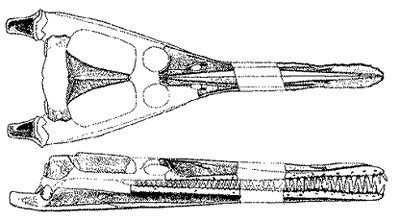 Macroplata: Swinton 1930; M. longirostris (= Plesiosaurus longirostris) Blake 1876.
Macroplata: Swinton 1930; M. longirostris (= Plesiosaurus longirostris) Blake 1876.
Range: Early Jurassic (Hettangian to Toarcian) of Europe.
Phylogeny: Pliosauridae: Maresaurus + Plesiopleurodon + (Kronosaurus + (Peloneustes + (Liopleurodon + (Pliosaurus + Brachauchenius)))) + *.
Characters: overall length 4.5-5.0 m; large skull (60-70 cm); relatively long neck with 29 short cervical vertebrae (twice length of skull); cervical vertebrae flattened; shoulder girdle modified to form bony ventral plates; coracoids narrow and much larger than scapulae; hindlimbs longer than forelimbs.
M. tenuiceps: from the Early Jurassic (Hettangian) of Warwickshire, England had a neck about twice the length of the crocodile-like head, with 29 shortened cervical (neck) vertebrae. M. tenuiceps had a shoulder girdle with coracoids that were proportionately much larger than the scapulae, indicating a powerful forward stroke for fast swimming. Length of this species 4.5 meters, skull: 58 cm long.
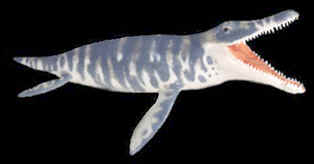 M. longirostris: from the Upper Lias Ammonites serpentinus subzone (Toarcian) of Whitby, Yorkshire, England had an even more elongate skull, 72 cm in length. It is not certain how much of the associated skeleton is from the same animal as the skull, or even whether the species belongs in the genus Macroplata. It has been suggested that it might be a type of Rhomaleosaurus). If it is a Macroplata it shows the evolutionary succession of this lineage over some fifteen million years. Overall length 5 meters long; skull 70 cm long.
M. longirostris: from the Upper Lias Ammonites serpentinus subzone (Toarcian) of Whitby, Yorkshire, England had an even more elongate skull, 72 cm in length. It is not certain how much of the associated skeleton is from the same animal as the skull, or even whether the species belongs in the genus Macroplata. It has been suggested that it might be a type of Rhomaleosaurus). If it is a Macroplata it shows the evolutionary succession of this lineage over some fifteen million years. Overall length 5 meters long; skull 70 cm long.
Image: Right: M. longirostris skull from White 1940).
Links: DinoData Marine Reptiles Pliosauroidae; Plesiosauria Translation and Pronunciation Guide; Dinosaurios Spanish); Mr. Fred Meyer's Macroplata QTVR Object; Rettili del mare Italian: very brief); JURÁSSICO Spanish); ERA MESOZÓICA plessiossauros Portuguese); Lexique Dinosaures. Le Macroplata.Fiche.Images.(French: succinct encyclopedia-type entry); Paleontology and Geology Glossary- Ma. ATW031212, MAK990830.
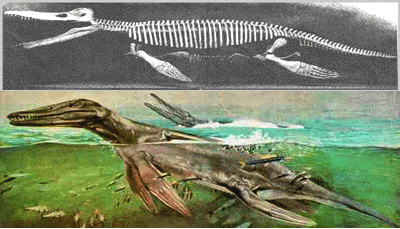 Kronosaurus: K. queenslandicus Longman, K. boyacensis Hampe 1992.
Kronosaurus: K. queenslandicus Longman, K. boyacensis Hampe 1992.
Range: Early Cretaceous (Albian) of Australia & South America
Phylogeny: Pliosauridae:: (Peloneustes + (Liopleurodon + (Pliosaurus + Brachauchenius))) + *.
Characters: said to be largest known pliosaur at 12-15m; skull ~3m long; neck short; 12 cervical vertebrae.
Note: During the middle Cretaceous period the role of giant marine predator was filled by the formidable Kronosaurus. Despite being a popular prehistoric marine reptile, featured in many paleontology text books and popular dinosaur books (as a sort of aquatic T. rex), Kronosaurus is a rather misunderstood genus. It has been variously included among the Pliosauridae and Polycotylidae. It may even belong in its own family. There seem to be at least three species:
Kronosaurus "queenslandicus" sp. This is the famous Harvard Kronosaurus. A Harvard expedition in 1931-1932 recovered two specimens of large pliosaurs from near Richmond, Queensland. Although identified with the type species Kronosaurus queenslandicus the skull is much higher as reconstructed, and the animal as a whole a little smaller. Wallumbilla Formation, Aptian age.
The famous vertebrate palaeontogist Alfred Sherwood Romer helped mount the giant skeleton in the Harvard Museum of Comparative Zoology in the 1950s, but much of material was badly eroded. Romer and his team were forced to fill in many details using plaster; in fact so much plaster that the specimen acquired the derisive nickname "Plasterosaurus" in some quarters. Romer gave the skeleton a whopping 30 dorsal vertebrae, stretching their Kronosaurus to 12.8 meters. Although the dimensions of the limb girdles are consistent with Romer's reconstruction, others have asserted that the actual length (when excess vertebrae are removed) is around 8 or 9 meters.
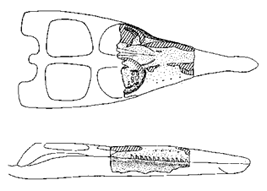 Kronosaurus boyacensis Hampe 1992 is a large pliosaur recently discovered in the Boyaca region of northern Columbia and dated to the late Aptian. The specimen included a fairly complete skull and much of the skeleton except the tail. It has 12 cervical, 3 pectoral, 19 dorsal, and 5 sacral vertebrae. The animal was probably about 9 meters (30 feet) long in life. It is unusual for its thickened ribs (not known in any other large pliosaur).
Kronosaurus boyacensis Hampe 1992 is a large pliosaur recently discovered in the Boyaca region of northern Columbia and dated to the late Aptian. The specimen included a fairly complete skull and much of the skeleton except the tail. It has 12 cervical, 3 pectoral, 19 dorsal, and 5 sacral vertebrae. The animal was probably about 9 meters (30 feet) long in life. It is unusual for its thickened ribs (not known in any other large pliosaur).
Kronosaurus queenslandicus Longman 1901 was actually erected on jaw fragments found near Hughenden, central-western Queensland, Australia, in the 1920s. This creature had a flattened head very different from the Harvard specimen. It is from the Toolebuc Formation, Albian age (Early Cretaceous). A second partial skull from the same locality also differs from the Harvard specimen. The skull (illustrated at left) is very broad, low, and flat (the fragment is 87 cm across but only 13 cm high), with the large, upwardly directed orbits of an ambush predator. Matching those measurements with the above sketch, the total length of the skull would have been around 2.85 meters, far bigger than any theropod dinosaur skull. This species seems to be somewhat larger than the Harvard specimen, so perhaps in life it would have attained 10 meters or more in length - equal in size to the large Jurassic pliosaurs.
Links: Prehistoric animal - Kronosaurus - Cretaceous Reptile; Kronosaurus queenslandicus; varner06.jpg; Dino-Dispatches No. 1, 11/08/1998, Giant pliosaurs -- real and imaginary; Queensland Museum - Dinosaurs of Ancient Queensland - Dinosaurs! - Kronosaurus; Marine Reptiles (NOT Dinosaurs). MAK990813.
checked ATW060216
Using this material. All material by ATW is public domain and may be freely used in any way (also any material jointly written by ATW and MAK). All material by MAK is licensed Creative Commons Attribution License Version 3.0, and may be freely used provided acknowedgement is given. All Wikipedia material is either Gnu Open Source or Creative Commons (see original Wikipedia page for details). Other graphics are copyright their respective owners